Human Anatomy and Physiology 1 Report: Homeostasis and Genetics
VerifiedAdded on 2023/01/10
|23
|3994
|37
Report
AI Summary
This report provides a comprehensive overview of human anatomy and physiology, delving into the structure and function of various organ systems. It begins by describing the fundamental building blocks of the human body, including cells and tissues, and then explores the organization of organs and organ systems. The report outlines the structure and function of key systems such as the endocrine, nervous, digestive, cardiovascular, respiratory, urinary, muscular, skeletal, immune, integumentary, and reproductive systems. It also examines the relationships between these systems, particularly focusing on the respiratory system's interactions with others. Furthermore, the report explores the process of homeostasis, detailing its importance in maintaining a healthy internal environment, including the roles of the nervous and endocrine systems. Finally, it touches upon the concepts of genetic inheritance, genetic screening, and the role of genetic counseling in healthcare practices.
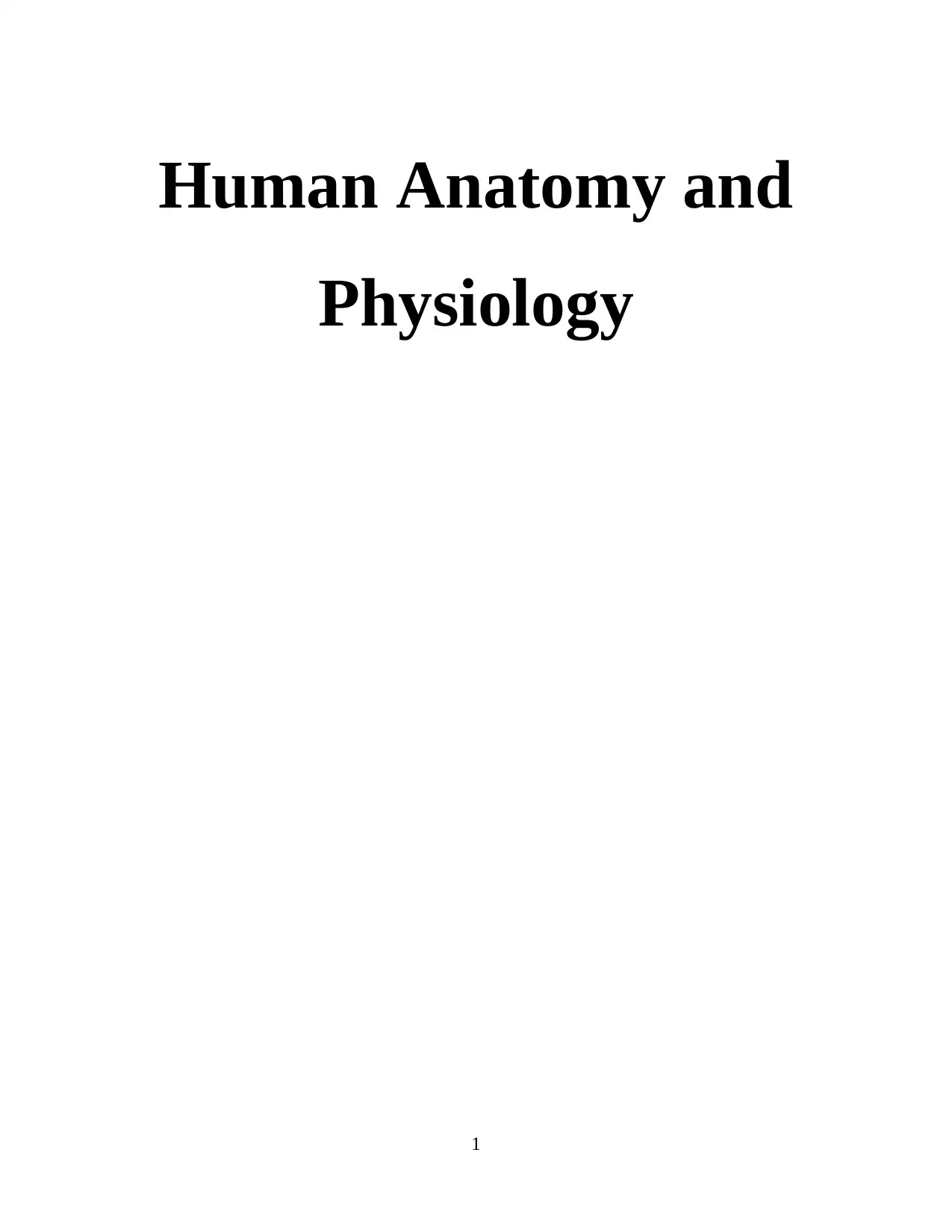
Human Anatomy and
Physiology
1
Physiology
1
Paraphrase This Document
Need a fresh take? Get an instant paraphrase of this document with our AI Paraphraser
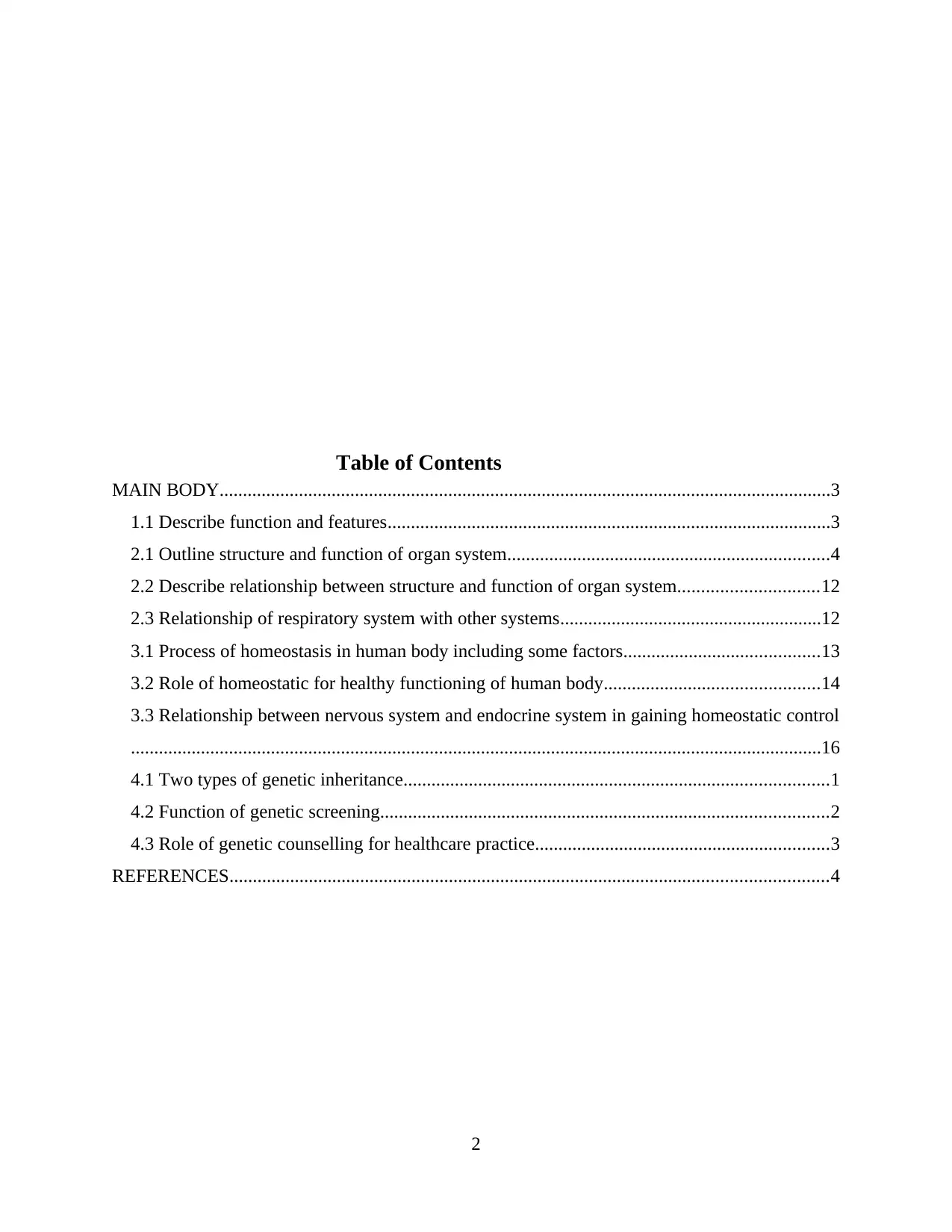
Table of Contents
MAIN BODY...................................................................................................................................3
1.1 Describe function and features...............................................................................................3
2.1 Outline structure and function of organ system.....................................................................4
2.2 Describe relationship between structure and function of organ system..............................12
2.3 Relationship of respiratory system with other systems........................................................12
3.1 Process of homeostasis in human body including some factors..........................................13
3.2 Role of homeostatic for healthy functioning of human body..............................................14
3.3 Relationship between nervous system and endocrine system in gaining homeostatic control
....................................................................................................................................................16
4.1 Two types of genetic inheritance...........................................................................................1
4.2 Function of genetic screening................................................................................................2
4.3 Role of genetic counselling for healthcare practice...............................................................3
REFERENCES................................................................................................................................4
2
MAIN BODY...................................................................................................................................3
1.1 Describe function and features...............................................................................................3
2.1 Outline structure and function of organ system.....................................................................4
2.2 Describe relationship between structure and function of organ system..............................12
2.3 Relationship of respiratory system with other systems........................................................12
3.1 Process of homeostasis in human body including some factors..........................................13
3.2 Role of homeostatic for healthy functioning of human body..............................................14
3.3 Relationship between nervous system and endocrine system in gaining homeostatic control
....................................................................................................................................................16
4.1 Two types of genetic inheritance...........................................................................................1
4.2 Function of genetic screening................................................................................................2
4.3 Role of genetic counselling for healthcare practice...............................................................3
REFERENCES................................................................................................................................4
2
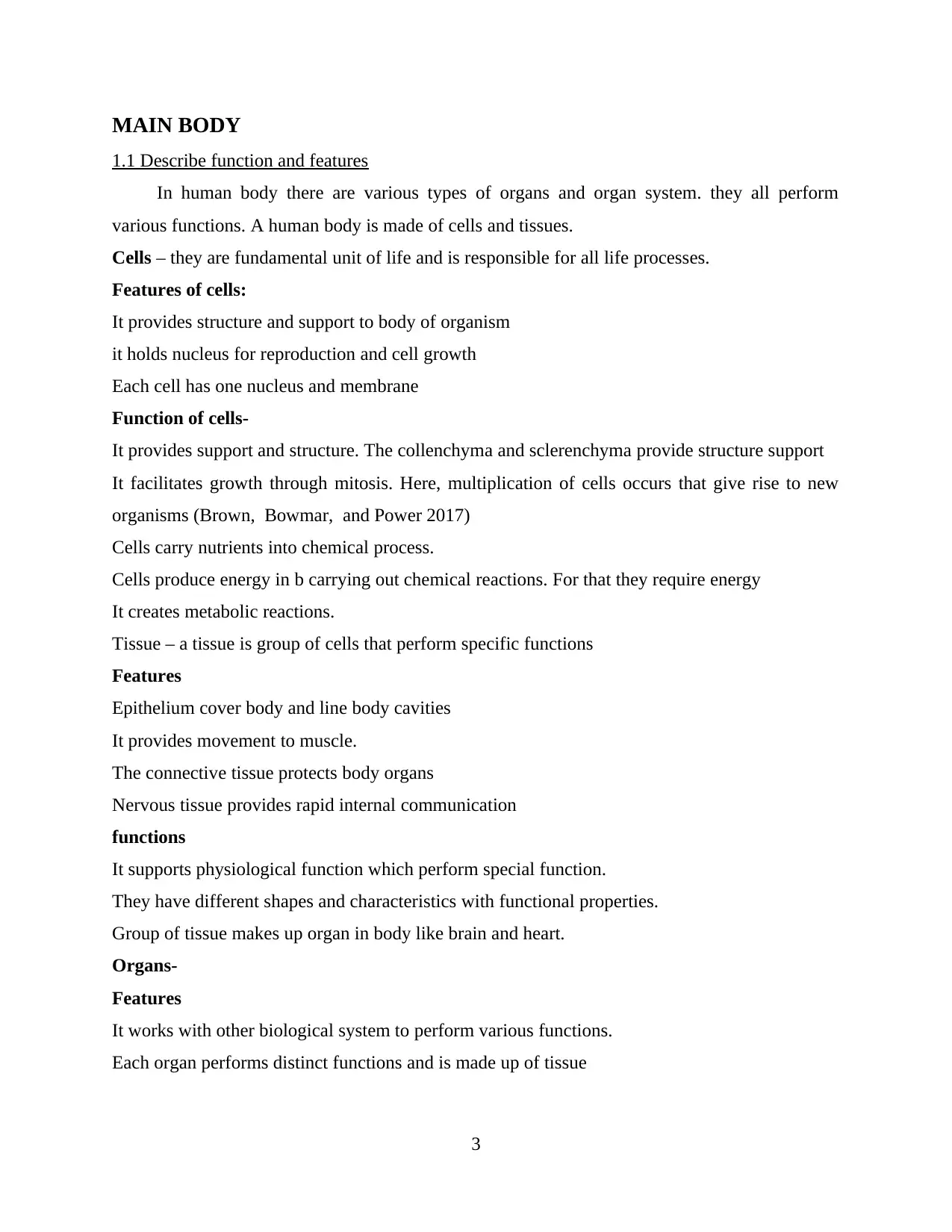
MAIN BODY
1.1 Describe function and features
In human body there are various types of organs and organ system. they all perform
various functions. A human body is made of cells and tissues.
Cells – they are fundamental unit of life and is responsible for all life processes.
Features of cells:
It provides structure and support to body of organism
it holds nucleus for reproduction and cell growth
Each cell has one nucleus and membrane
Function of cells-
It provides support and structure. The collenchyma and sclerenchyma provide structure support
It facilitates growth through mitosis. Here, multiplication of cells occurs that give rise to new
organisms (Brown, Bowmar, and Power 2017)
Cells carry nutrients into chemical process.
Cells produce energy in b carrying out chemical reactions. For that they require energy
It creates metabolic reactions.
Tissue – a tissue is group of cells that perform specific functions
Features
Epithelium cover body and line body cavities
It provides movement to muscle.
The connective tissue protects body organs
Nervous tissue provides rapid internal communication
functions
It supports physiological function which perform special function.
They have different shapes and characteristics with functional properties.
Group of tissue makes up organ in body like brain and heart.
Organs-
Features
It works with other biological system to perform various functions.
Each organ performs distinct functions and is made up of tissue
3
1.1 Describe function and features
In human body there are various types of organs and organ system. they all perform
various functions. A human body is made of cells and tissues.
Cells – they are fundamental unit of life and is responsible for all life processes.
Features of cells:
It provides structure and support to body of organism
it holds nucleus for reproduction and cell growth
Each cell has one nucleus and membrane
Function of cells-
It provides support and structure. The collenchyma and sclerenchyma provide structure support
It facilitates growth through mitosis. Here, multiplication of cells occurs that give rise to new
organisms (Brown, Bowmar, and Power 2017)
Cells carry nutrients into chemical process.
Cells produce energy in b carrying out chemical reactions. For that they require energy
It creates metabolic reactions.
Tissue – a tissue is group of cells that perform specific functions
Features
Epithelium cover body and line body cavities
It provides movement to muscle.
The connective tissue protects body organs
Nervous tissue provides rapid internal communication
functions
It supports physiological function which perform special function.
They have different shapes and characteristics with functional properties.
Group of tissue makes up organ in body like brain and heart.
Organs-
Features
It works with other biological system to perform various functions.
Each organ performs distinct functions and is made up of tissue
3
⊘ This is a preview!⊘
Do you want full access?
Subscribe today to unlock all pages.

Trusted by 1+ million students worldwide
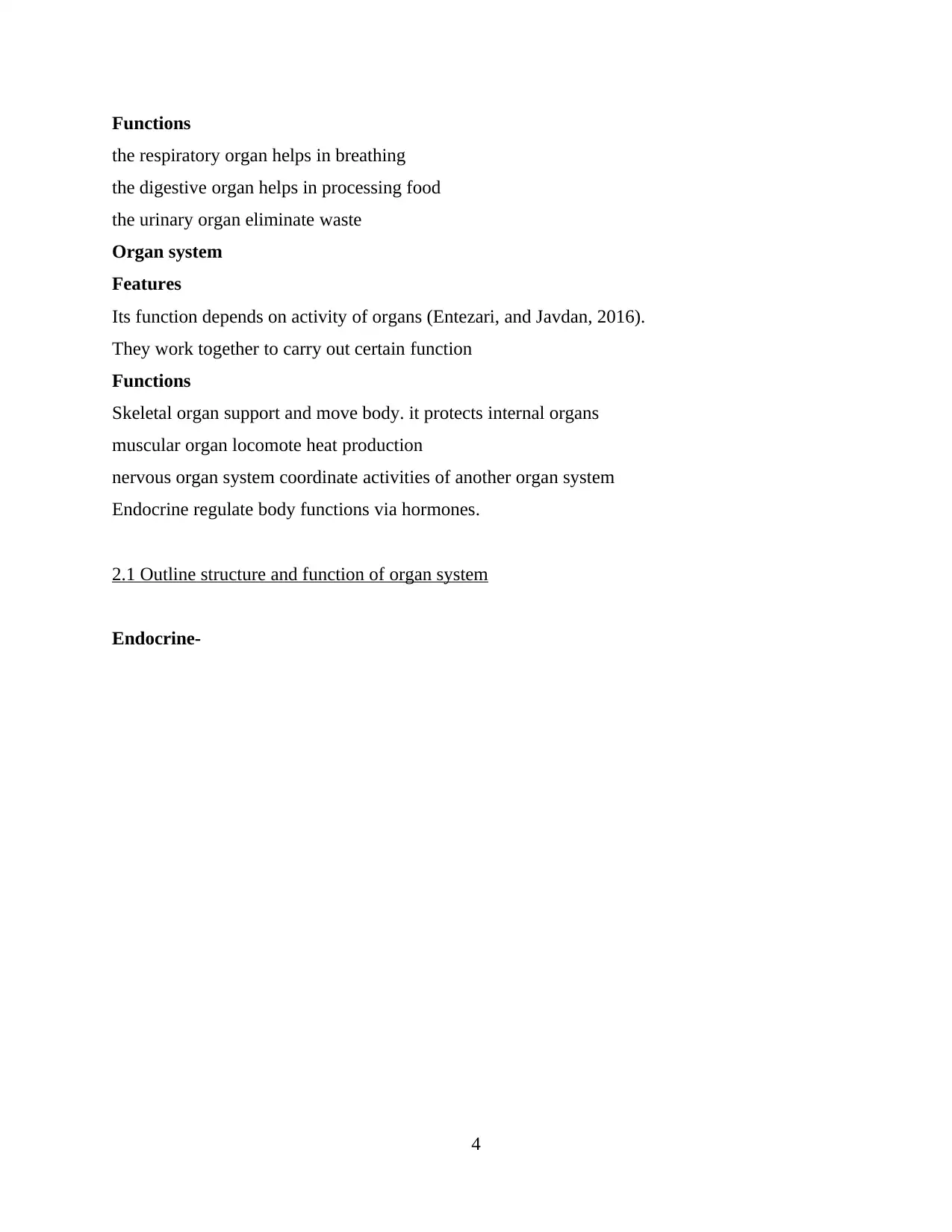
Functions
the respiratory organ helps in breathing
the digestive organ helps in processing food
the urinary organ eliminate waste
Organ system
Features
Its function depends on activity of organs (Entezari, and Javdan, 2016).
They work together to carry out certain function
Functions
Skeletal organ support and move body. it protects internal organs
muscular organ locomote heat production
nervous organ system coordinate activities of another organ system
Endocrine regulate body functions via hormones.
2.1 Outline structure and function of organ system
Endocrine-
4
the respiratory organ helps in breathing
the digestive organ helps in processing food
the urinary organ eliminate waste
Organ system
Features
Its function depends on activity of organs (Entezari, and Javdan, 2016).
They work together to carry out certain function
Functions
Skeletal organ support and move body. it protects internal organs
muscular organ locomote heat production
nervous organ system coordinate activities of another organ system
Endocrine regulate body functions via hormones.
2.1 Outline structure and function of organ system
Endocrine-
4
Paraphrase This Document
Need a fresh take? Get an instant paraphrase of this document with our AI Paraphraser
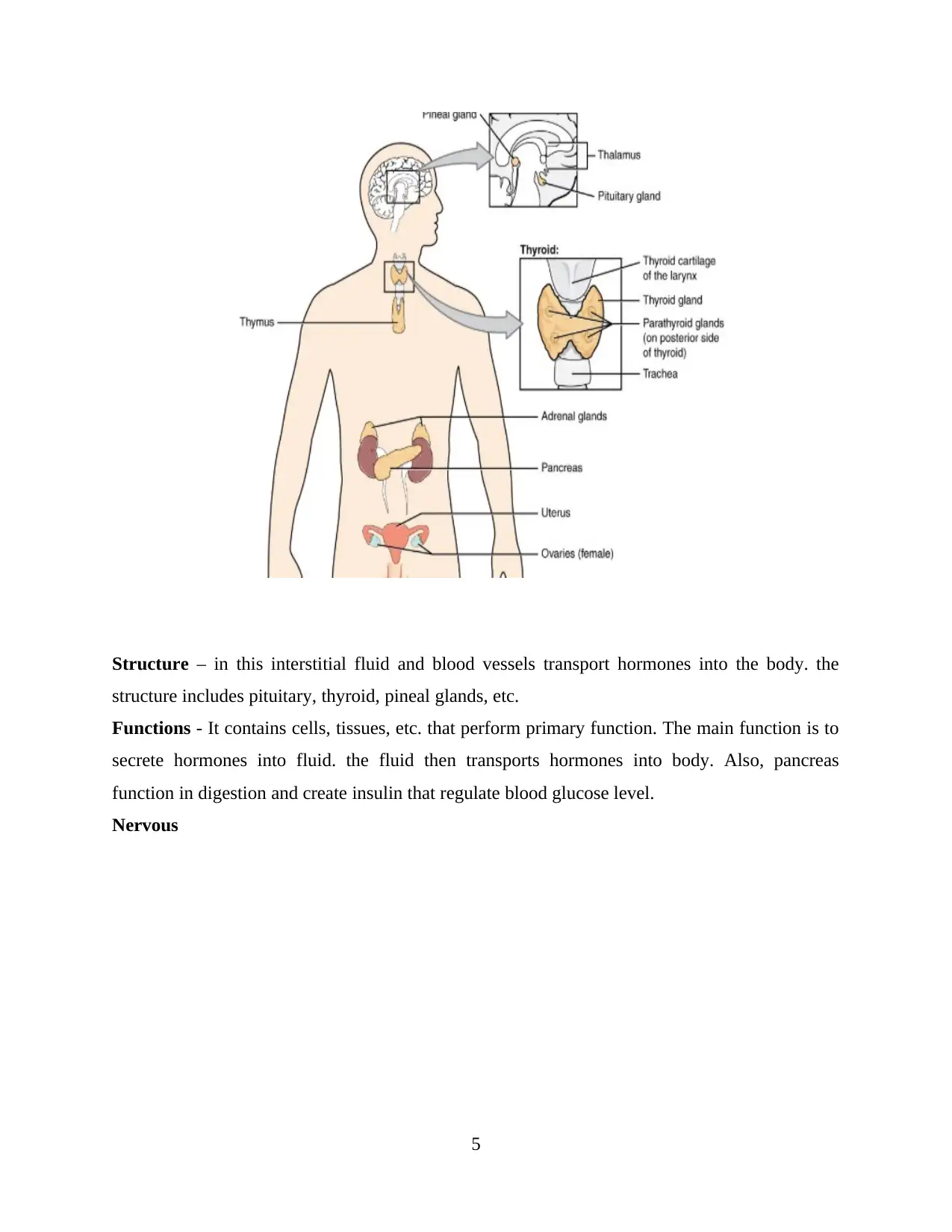
Structure – in this interstitial fluid and blood vessels transport hormones into the body. the
structure includes pituitary, thyroid, pineal glands, etc.
Functions - It contains cells, tissues, etc. that perform primary function. The main function is to
secrete hormones into fluid. the fluid then transports hormones into body. Also, pancreas
function in digestion and create insulin that regulate blood glucose level.
Nervous
5
structure includes pituitary, thyroid, pineal glands, etc.
Functions - It contains cells, tissues, etc. that perform primary function. The main function is to
secrete hormones into fluid. the fluid then transports hormones into body. Also, pancreas
function in digestion and create insulin that regulate blood glucose level.
Nervous
5
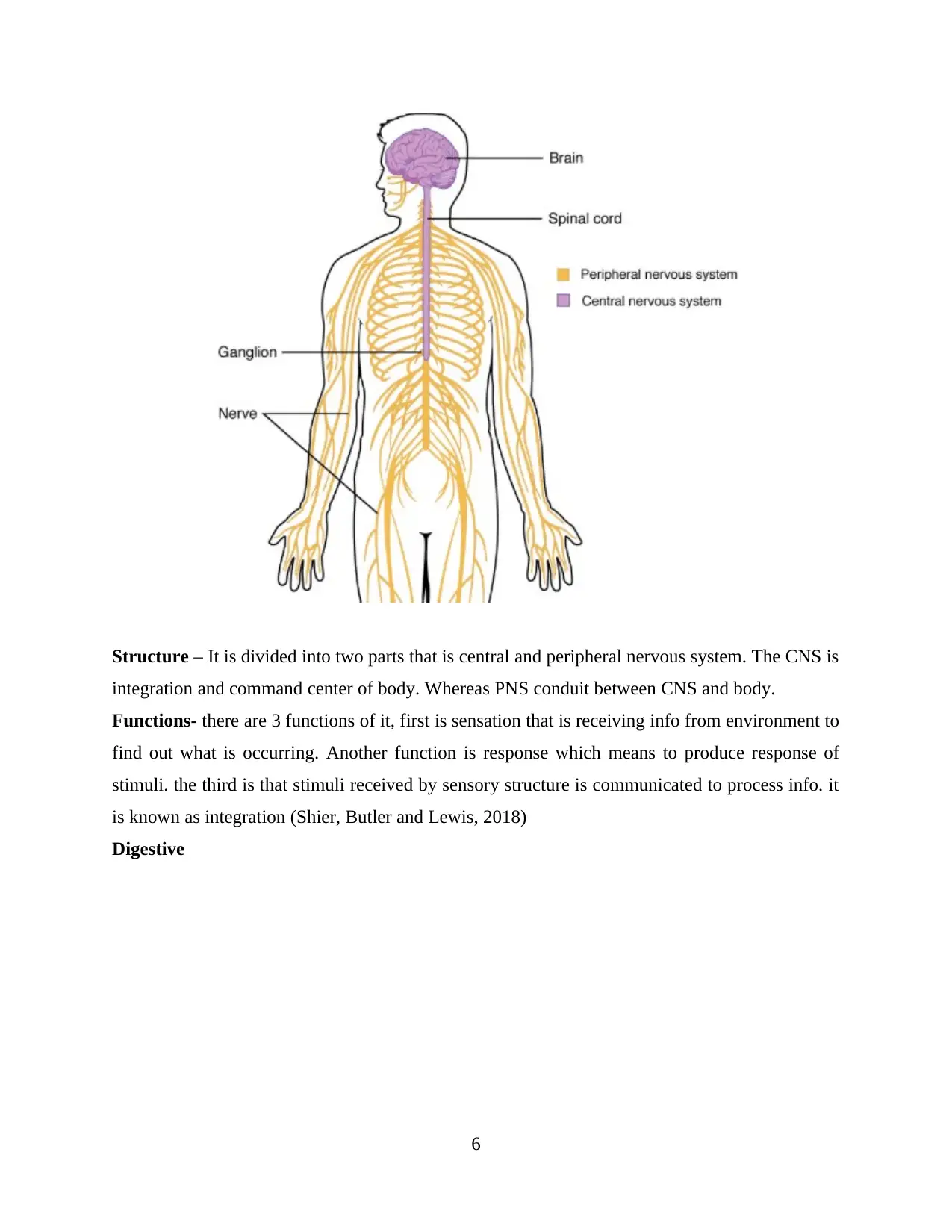
Structure – It is divided into two parts that is central and peripheral nervous system. The CNS is
integration and command center of body. Whereas PNS conduit between CNS and body.
Functions- there are 3 functions of it, first is sensation that is receiving info from environment to
find out what is occurring. Another function is response which means to produce response of
stimuli. the third is that stimuli received by sensory structure is communicated to process info. it
is known as integration (Shier, Butler and Lewis, 2018)
Digestive
6
integration and command center of body. Whereas PNS conduit between CNS and body.
Functions- there are 3 functions of it, first is sensation that is receiving info from environment to
find out what is occurring. Another function is response which means to produce response of
stimuli. the third is that stimuli received by sensory structure is communicated to process info. it
is known as integration (Shier, Butler and Lewis, 2018)
Digestive
6
⊘ This is a preview!⊘
Do you want full access?
Subscribe today to unlock all pages.

Trusted by 1+ million students worldwide
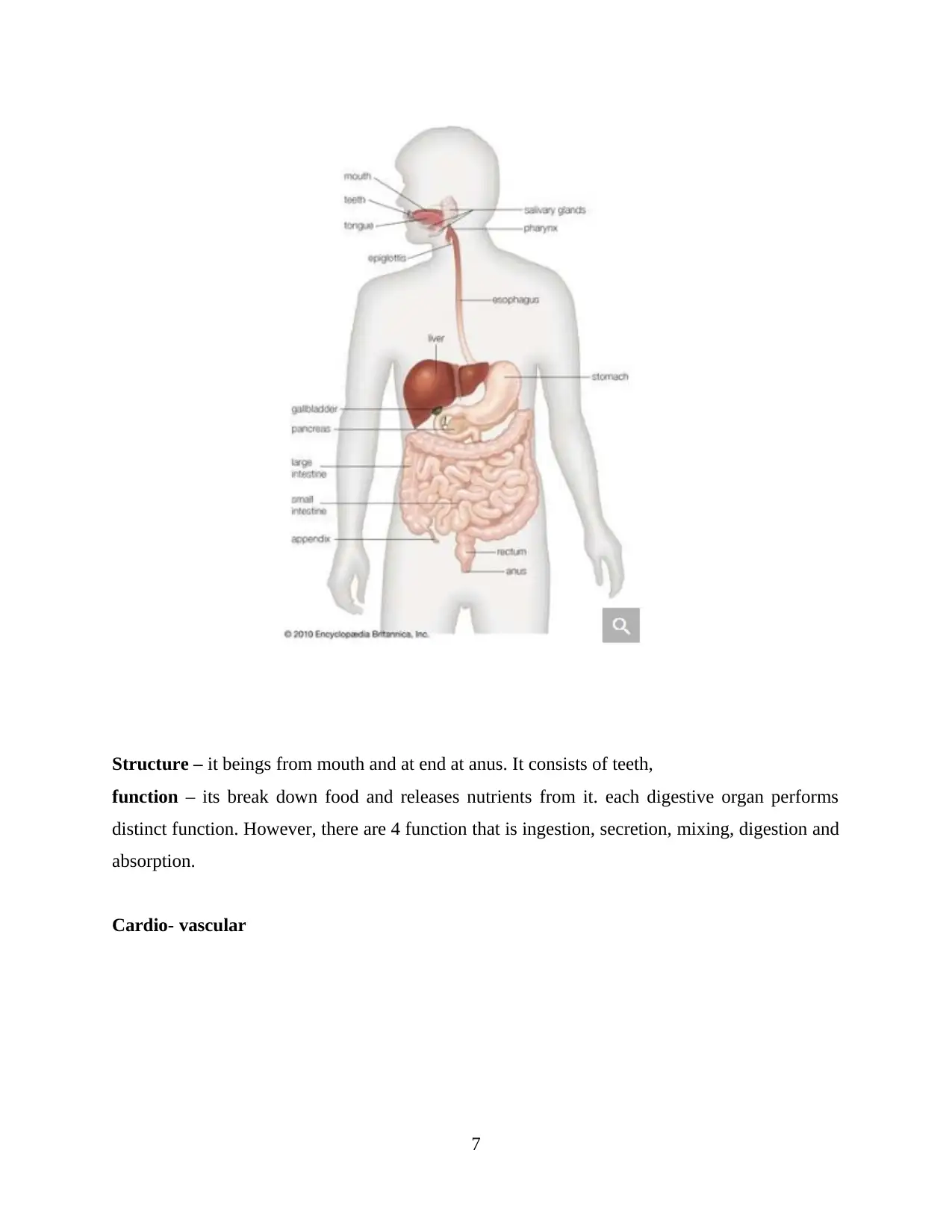
Structure – it beings from mouth and at end at anus. It consists of teeth,
function – its break down food and releases nutrients from it. each digestive organ performs
distinct function. However, there are 4 function that is ingestion, secretion, mixing, digestion and
absorption.
Cardio- vascular
7
function – its break down food and releases nutrients from it. each digestive organ performs
distinct function. However, there are 4 function that is ingestion, secretion, mixing, digestion and
absorption.
Cardio- vascular
7
Paraphrase This Document
Need a fresh take? Get an instant paraphrase of this document with our AI Paraphraser
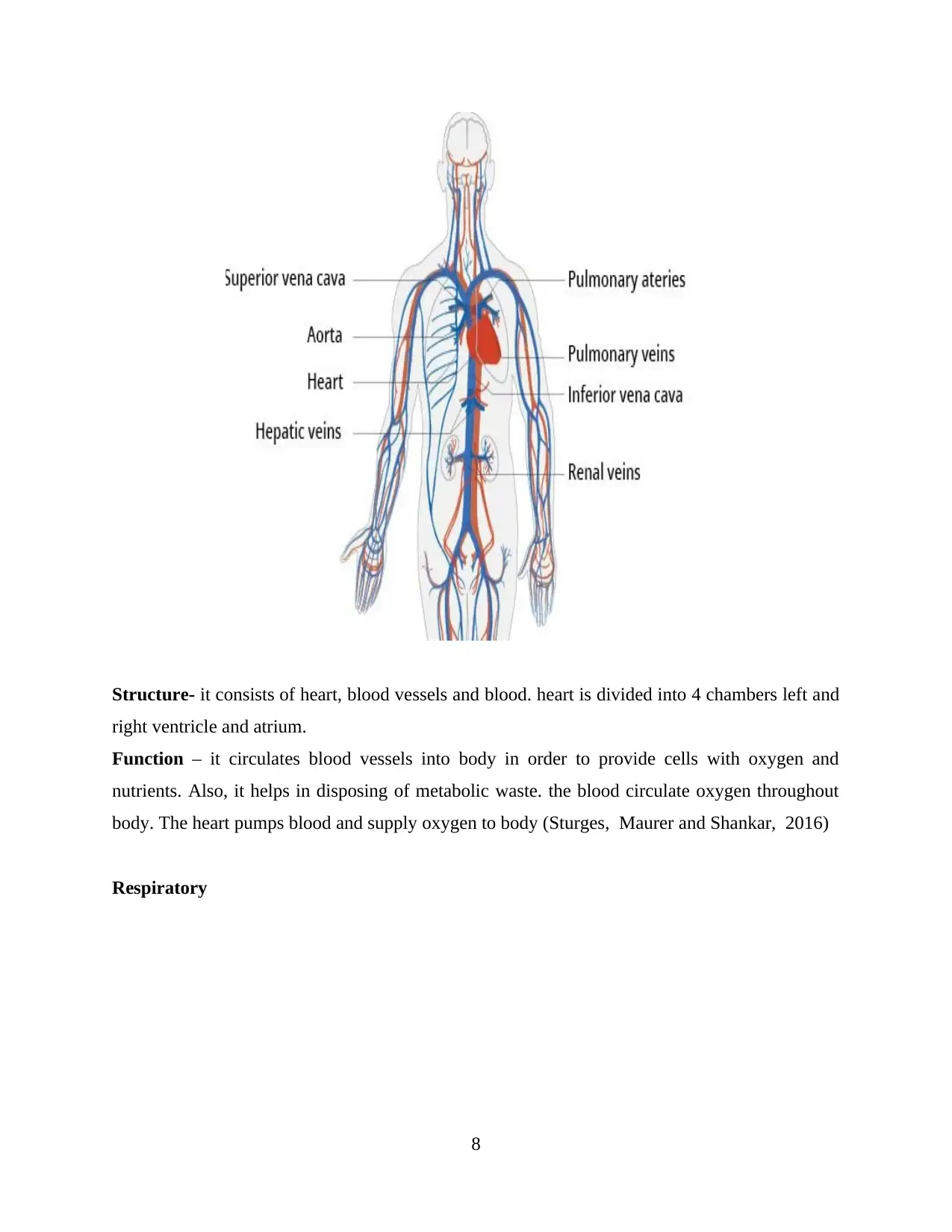
Structure- it consists of heart, blood vessels and blood. heart is divided into 4 chambers left and
right ventricle and atrium.
Function – it circulates blood vessels into body in order to provide cells with oxygen and
nutrients. Also, it helps in disposing of metabolic waste. the blood circulate oxygen throughout
body. The heart pumps blood and supply oxygen to body (Sturges, Maurer and Shankar, 2016)
Respiratory
8
right ventricle and atrium.
Function – it circulates blood vessels into body in order to provide cells with oxygen and
nutrients. Also, it helps in disposing of metabolic waste. the blood circulate oxygen throughout
body. The heart pumps blood and supply oxygen to body (Sturges, Maurer and Shankar, 2016)
Respiratory
8
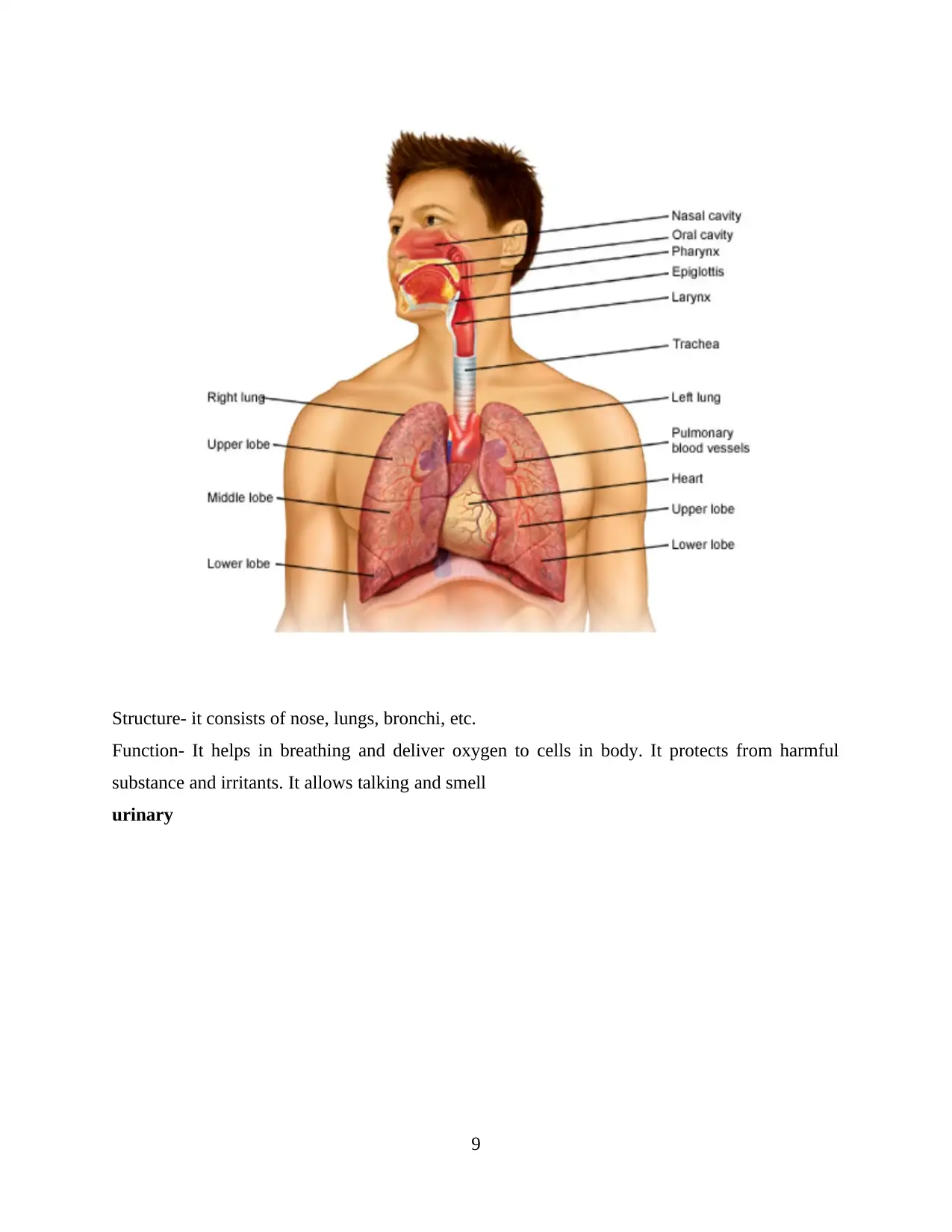
Structure- it consists of nose, lungs, bronchi, etc.
Function- It helps in breathing and deliver oxygen to cells in body. It protects from harmful
substance and irritants. It allows talking and smell
urinary
9
Function- It helps in breathing and deliver oxygen to cells in body. It protects from harmful
substance and irritants. It allows talking and smell
urinary
9
⊘ This is a preview!⊘
Do you want full access?
Subscribe today to unlock all pages.

Trusted by 1+ million students worldwide
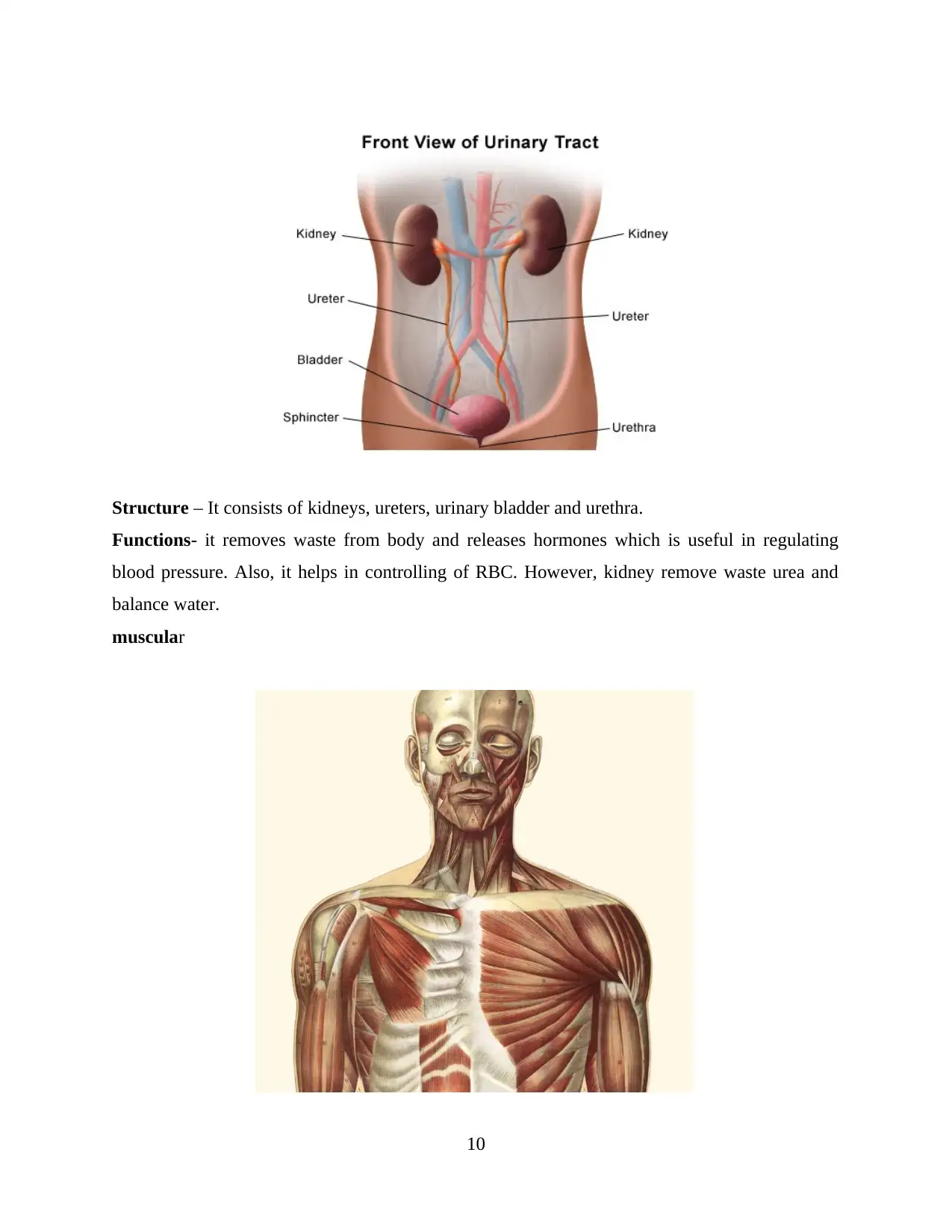
Structure – It consists of kidneys, ureters, urinary bladder and urethra.
Functions- it removes waste from body and releases hormones which is useful in regulating
blood pressure. Also, it helps in controlling of RBC. However, kidney remove waste urea and
balance water.
muscular
10
Functions- it removes waste from body and releases hormones which is useful in regulating
blood pressure. Also, it helps in controlling of RBC. However, kidney remove waste urea and
balance water.
muscular
10
Paraphrase This Document
Need a fresh take? Get an instant paraphrase of this document with our AI Paraphraser
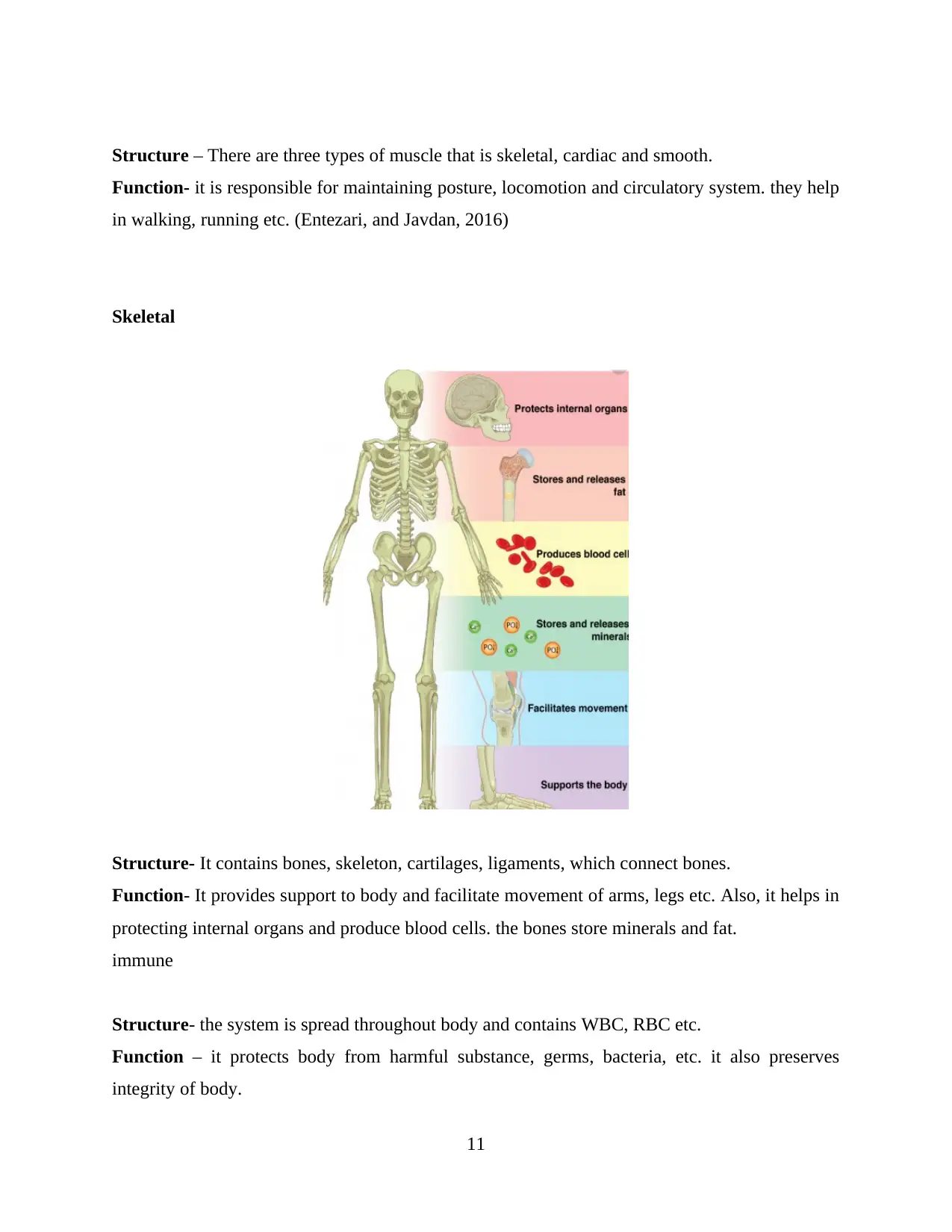
Structure – There are three types of muscle that is skeletal, cardiac and smooth.
Function- it is responsible for maintaining posture, locomotion and circulatory system. they help
in walking, running etc. (Entezari, and Javdan, 2016)
Skeletal
Structure- It contains bones, skeleton, cartilages, ligaments, which connect bones.
Function- It provides support to body and facilitate movement of arms, legs etc. Also, it helps in
protecting internal organs and produce blood cells. the bones store minerals and fat.
immune
Structure- the system is spread throughout body and contains WBC, RBC etc.
Function – it protects body from harmful substance, germs, bacteria, etc. it also preserves
integrity of body.
11
Function- it is responsible for maintaining posture, locomotion and circulatory system. they help
in walking, running etc. (Entezari, and Javdan, 2016)
Skeletal
Structure- It contains bones, skeleton, cartilages, ligaments, which connect bones.
Function- It provides support to body and facilitate movement of arms, legs etc. Also, it helps in
protecting internal organs and produce blood cells. the bones store minerals and fat.
immune
Structure- the system is spread throughout body and contains WBC, RBC etc.
Function – it protects body from harmful substance, germs, bacteria, etc. it also preserves
integrity of body.
11
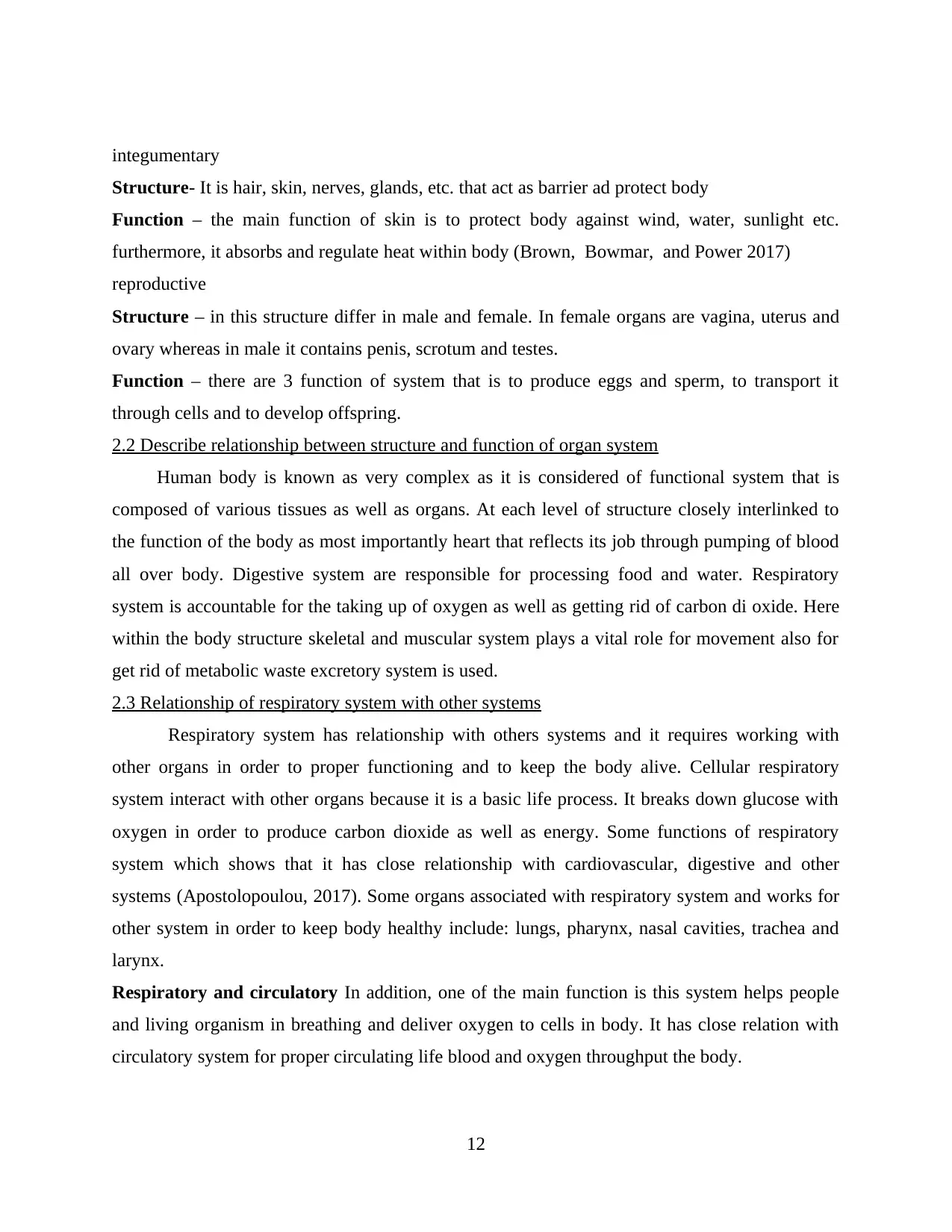
integumentary
Structure- It is hair, skin, nerves, glands, etc. that act as barrier ad protect body
Function – the main function of skin is to protect body against wind, water, sunlight etc.
furthermore, it absorbs and regulate heat within body (Brown, Bowmar, and Power 2017)
reproductive
Structure – in this structure differ in male and female. In female organs are vagina, uterus and
ovary whereas in male it contains penis, scrotum and testes.
Function – there are 3 function of system that is to produce eggs and sperm, to transport it
through cells and to develop offspring.
2.2 Describe relationship between structure and function of organ system
Human body is known as very complex as it is considered of functional system that is
composed of various tissues as well as organs. At each level of structure closely interlinked to
the function of the body as most importantly heart that reflects its job through pumping of blood
all over body. Digestive system are responsible for processing food and water. Respiratory
system is accountable for the taking up of oxygen as well as getting rid of carbon di oxide. Here
within the body structure skeletal and muscular system plays a vital role for movement also for
get rid of metabolic waste excretory system is used.
2.3 Relationship of respiratory system with other systems
Respiratory system has relationship with others systems and it requires working with
other organs in order to proper functioning and to keep the body alive. Cellular respiratory
system interact with other organs because it is a basic life process. It breaks down glucose with
oxygen in order to produce carbon dioxide as well as energy. Some functions of respiratory
system which shows that it has close relationship with cardiovascular, digestive and other
systems (Apostolopoulou, 2017). Some organs associated with respiratory system and works for
other system in order to keep body healthy include: lungs, pharynx, nasal cavities, trachea and
larynx.
Respiratory and circulatory In addition, one of the main function is this system helps people
and living organism in breathing and deliver oxygen to cells in body. It has close relation with
circulatory system for proper circulating life blood and oxygen throughput the body.
12
Structure- It is hair, skin, nerves, glands, etc. that act as barrier ad protect body
Function – the main function of skin is to protect body against wind, water, sunlight etc.
furthermore, it absorbs and regulate heat within body (Brown, Bowmar, and Power 2017)
reproductive
Structure – in this structure differ in male and female. In female organs are vagina, uterus and
ovary whereas in male it contains penis, scrotum and testes.
Function – there are 3 function of system that is to produce eggs and sperm, to transport it
through cells and to develop offspring.
2.2 Describe relationship between structure and function of organ system
Human body is known as very complex as it is considered of functional system that is
composed of various tissues as well as organs. At each level of structure closely interlinked to
the function of the body as most importantly heart that reflects its job through pumping of blood
all over body. Digestive system are responsible for processing food and water. Respiratory
system is accountable for the taking up of oxygen as well as getting rid of carbon di oxide. Here
within the body structure skeletal and muscular system plays a vital role for movement also for
get rid of metabolic waste excretory system is used.
2.3 Relationship of respiratory system with other systems
Respiratory system has relationship with others systems and it requires working with
other organs in order to proper functioning and to keep the body alive. Cellular respiratory
system interact with other organs because it is a basic life process. It breaks down glucose with
oxygen in order to produce carbon dioxide as well as energy. Some functions of respiratory
system which shows that it has close relationship with cardiovascular, digestive and other
systems (Apostolopoulou, 2017). Some organs associated with respiratory system and works for
other system in order to keep body healthy include: lungs, pharynx, nasal cavities, trachea and
larynx.
Respiratory and circulatory In addition, one of the main function is this system helps people
and living organism in breathing and deliver oxygen to cells in body. It has close relation with
circulatory system for proper circulating life blood and oxygen throughput the body.
12
⊘ This is a preview!⊘
Do you want full access?
Subscribe today to unlock all pages.

Trusted by 1+ million students worldwide
1 out of 23
Related Documents
Your All-in-One AI-Powered Toolkit for Academic Success.
+13062052269
info@desklib.com
Available 24*7 on WhatsApp / Email
![[object Object]](/_next/static/media/star-bottom.7253800d.svg)
Unlock your academic potential
Copyright © 2020–2025 A2Z Services. All Rights Reserved. Developed and managed by ZUCOL.





